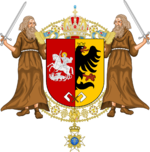Royal and Imperial Army (Urcea)
This article is a work-in-progress because it is incomplete and pending further input from an author. Note: The contents of this article are not considered canonical and may be inaccurate. Please comment on this article's talk page to share your input, comments and questions. |
| Royal and Imperial Army | |
|---|---|
 Emblem of the Royal and Imperial Army | |
| Founded | 1591 |
| Country | |
| Type | Army |
| Role | Land warfare |
| Size | 4,071,512 regular personnel 4,490,798 reservists |
| Part of | Armed Forces of the Apostolic Kingdom of Urcea |
| Patron | Riordan VIII |
| Commanders | |
| Magister Militum | Livio Iarnán |
The Royal and Imperial Army is the principal land warfare force of Urcea, a part of Armed Forces of the Apostolic Kingdom of Urcea. In the 2010s, the Royal and Imperial Army was comprised of just over four million active personnel with a similar number of enrolled reservists.
The modern Army traces its history back to 1591 upon establishment of a standing army by King Leo II. The term Royal and Imperial Army was used whenever the Apostolic King of Urcea also held the title Emperor of the Levantines, and has been the permanent name of the force since the Treaty of Corcra due to an ongoing legal fiction tying Urcea to the Empire. Members of the Royal and Imperial Army swear allegiance to the monarch as their commander-in-chief, though precedents established during the Aedanicad and before invest most authority with the Procurator, who holds the title of Magister Militum. The army is administered by the Ministry for the Armed Services and commanded by the Deputy Lord Marshal for the Army.
The Royal and Imperial Army has seen action in major wars between the world's great powers, most especially including the Second Great War. The strength of the armies in the Caroline Wars allowed Urcea to become the preeminent military and geopolitical power in Levantia. Since the end of the Occidental Cold War and beginning of The Deluge, the Army has primarily been involved in both offensive and peacekeeping operations throughout northern Crona and Cusinaut.
Name
History
Premodern Army
18th century organizational changes
19th century reform impacts
Rising and division
The Royal Army went under the name "Regal Army" during the time of the Crown Regency (1889-1902). This period, where no Apostolic King of Urcea sat on the throne and Gréagóir FitzRex ruled as regent saw the Army assume greater control over the authority of the state; for this reason, it is commonly referred to as the "Rifled State". The "military privilegiata" - a subset of career officers from the privilegiata class - served as a rulign class during this period, being both FitzRex's primary supporters as well as implements of his will. P.G.W. Gelema commented that "there was no separation...between the military privilegiata and the Regency...it was a state administered by them for their benefit." Accordingly, the Regal Army participated in several acts of political suppression against regime opponents in the near decade and a half of regency.
Despite the near ubiquitous support for the regime among the higher ranking officers of the Regal Army, support for the regime was limited at best among the lower ranking officers and enlisted personnel. As of 1895, the vast majority of the enlisted men of the Regal Army was comprised of freemen, who felt no fondness for and extracted no benefit from the Rifled State. Although the Army remained united through the very earliest months of the '97 Rising - namely July and August - widespread discontentment filled the army as guerilla engagements increased in regularity toward late summer.
Creation of the modern army
Cold War and Deluge army
Organization
Planning
Army Components
Army commands and army service component commands
Structure
Volunteers
The Royal Army Volunteers are a component of the Royal and Imperial Army that fields "volunteer" - i.e. non-professional - units, mostly during wartime. Though separately organized than the Royal and Imperial Army and with a mostly breveted officer corps, the Royal Army Volunteers functionally serve as the method through which the nation's reserve component is organized for military service. Members of the Royal Army Volunteers are paid by the subdivisions of Urcea, who are responsible for organizing the units. Units organized through the Royal Army Volunteers are almost always regimental in size and are placed under the command of the Royal and Imperial Army after they are mustered, retrained for a month, and federalized. Unlike service in the Royal and Imperial Army, members of the Royal Army Volunteers term of service are typically three years or the conclusion of an armed conflict, whichever is earlier.
The Volunteers, once the bulk of Urcean manpower during several of the Caroline Wars and beyond, have been largely rendered unnecessary by the increase in size of the regular army, though they were mobilized twice in the modern era - during the Second Great War and during the Final War of the Deluge.